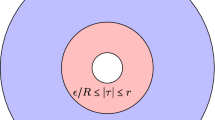Abstract
We offer a quick introduction to certain recent aspects of Donaldson–Thomas theory in the context of curve-counting invariants. We present a new computation which recasts the correspondence between the Gromov–Witten and Donaldson–Thomas theories of a Calabi–Yau threefold in the language of flat connections, their monodromy, and their flat sections.
Similar content being viewed by others
Notes
In the apprach of [1, 6], fixing a generic Z, one introduces a formal parameter s and an inverse system of principal bundles \(P^j = {\text {Aut}}({\mathbb {C}}[\Gamma ][s]/(s)^j) \times {\mathbb {C}}^*\), with connections \(\nabla ^j\), whose generalised monodromies converge to a formal power series version of \(\{{\mathbb {S}}_{\ell }(Z), \ell \subset {\mathbb {C}}^*\}\), and are constant in a possibly decreasing sequence of open neighbourhoods \(U_j\) of Z in \({\text {Hom}}(\Gamma , {\mathbb {C}})\). But in general, without extra finiteness assumptions, we have \(\cap _{j} U_j= \emptyset \).
The appearence of branch cuts is expected: around a double pole, the “canonical solutions” of a holomorphic differential equation are only defined in a sector.
We assume primitivity and the vanishing in order to simplify the statement. A similar result holds in general.
Rays of this type could be dense in a region, and in general the statement only makes sense for each \((P^i, \nabla ^i)\).
The operator \([q^n]\) applied to Laurent polynomials extracts the coefficient of \(q^n\).
References
Barbieri, A., Stoppa, J.: Frobenius type and CV-structures for Donaldson–Thomas theory and a convergence property. Comm. Anal. Geom. 27(2), 287–327 (2019)
Bridgeland, T.: Riemann–Hilbert problems from Donaldson–Thomas theory. Invent. Math. 216(1), 69–124 (2019)
Bridgeland, T., Toledano-Laredo, V.: Stability conditions and Stokes factors. Invent. Math. 187(1), 61–98 (2012)
Donaldson, S.K., Thomas, R.P.: Gauge Theory in Higher Dimensions, The Geometric Universe (Oxford, 1996), pp. 31–47. Oxford University Press, Oxford (1998)
Felder, G., Kazhdan, D.: Regularization of divergent integrals. Sel. Math. (N.S.) 24(1), 157–186 (2018)
Filippini, S., Garcia Fernandez, M., Stoppa, J.: Stability data, irregular connections and tropical curves. Sel. Math. (N.S.) 23(2), 1355–1418 (2017)
Filippini, S., Stoppa, J.: TBA type equations and tropical curves. Int. J. Math. 27(7), 1640005 (2016)
Gaiotto, D.: Opers and TBA. arXiv:1403.6137 [hep-th]
Gaiotto, D., Moore, G., Neitzke, A.: Four dimensional wall-crossing via three-dimensional field theory. Comm. Math. Phys. 299(1), 163–224 (2010)
Gopakumar, R., Vafa, C.: M-theory and topological strings. II. arXiv:hep-th/9812127 (1998)
Joyce, D.: Holomorphic generating functions for invariants counting coherent sheaves on Calabi-Yau 3-folds. Geom. Topol. 11, 667–725 (2007)
Joyce, D., Song, Y.: A theory of generalized Donaldson–Thomas invariants. Mem. Am. Math. Soc. 217(1020), iv+199 (2012). ISBN: 978-0-8218-5279-8
Kontsevich, M., Soibelman, Y.: Stability structures, motivic Donaldson–Thomas invariants and cluster transformations. arXiv:0811.2435 [math.AG]
Maulik, D., Nekrasov, N., Okounkov, A., Pandharipande, R.: Gromov–Witten theory and Donaldson–Thomas theory. I. Compos. Math. 142(5), 1263–1285 (2006)
Maulik, D., Toda, Y.: Gopakumar–Vafa invariants via vanishing cycles. Invent. Math. 213(3), 1017–1097 (2018)
Pandharipande, R., Pixton, A.: GW/P correspondence for the quintic 3-fold. J. Am. Math. Soc. 30, 389–449 (2017)
Pandharipande, R., Thomas, R.: Curve counting via stable pairs in the derived category. Invent. Math. 178(2), 407–447 (2009)
Pandharipande, R., Thomas, R.: Stable pairs and BPS invariants. J. Am. Math. Soc. 23(1), 267–297 (2010)
Scalise, J., Stoppa, J.: Variations of BPS structure and a large rank limit. J. Inst. Math. Jussieu. (2017). https://doi.org/10.1017/S1474748019000136
Stoppa, J.: Joyce–Song wall-crossing as an asymptotic expansion. Kyoto J. Math. 54(1), 103–156 (2014)
Stoppa, J.: A note on BPS structures and Gopakumar–Vafa invariants. Commun. Number Theory Phys. 13(3), 627–645 (2019)
Thomas, R.P.: A holomorphic Casson invariant for Calabi-Yau 3-folds, and bundles on K3 fibrations. J. Differ. Geom. 54(2), 367–438 (2000)
Toda, Y.: Curve counting theories via stable objects I. DT/PT correspondence. J. Am. Math. Soc. 23(4), 1119–1157 (2010)
Toda, Y.: Curve counting invariants around the conifold point. J. Differ. Geom. 89(1), 133–184 (2011)
Toda, Y.: Stability conditions and curve counting invariants on Calabi-Yau 3-folds. Kyoto J. Math. 52(1), 1–50 (2012)
Toda, Y.: Hall algebras in the derived category and higher rank DT invariants. arXiv:1601.07519v2 [math.AG]
Toda, Y.: Gopakumar–Vafa invariants and wall-crossing. arXiv:1710.01843 [math.AG]
Acknowledgements
I thank A. Barbieri, T. Bridgeland, J. Scalise, and R. Thomas for important comments and suggestions about this work. I am grateful to the organisers and participants in the workshop D-modules, quantum geometry, and related topics, Kyoto, December 2018, and in the XXI Congresso UMI, Pavia, September 2019, for very helpful feedback. The research leading to these results has received funding from the European Research Council under the European Union’s Seventh Framework Programme (FP7/2007-2013) / ERC Grant agreement no. 307119.
Author information
Authors and Affiliations
Corresponding author
Additional information
Publisher's Note
Springer Nature remains neutral with regard to jurisdictional claims in published maps and institutional affiliations.
Rights and permissions
About this article
Cite this article
Stoppa, J. Stable pairs, flat connections and Gopakumar–Vafa invariants. Boll Unione Mat Ital 14, 117–136 (2021). https://doi.org/10.1007/s40574-020-00243-8
Received:
Accepted:
Published:
Issue Date:
DOI: https://doi.org/10.1007/s40574-020-00243-8



